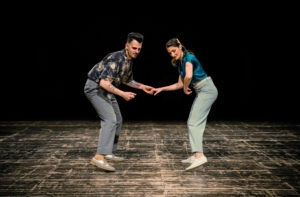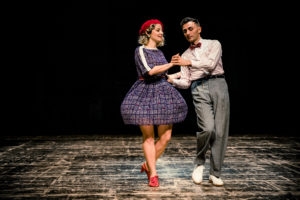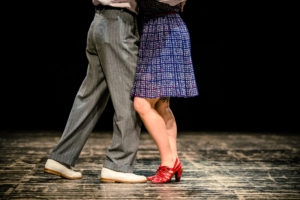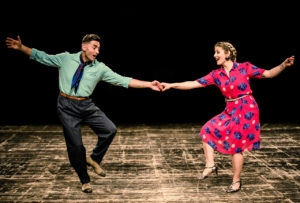The Charleston is a style of dance that became popular in America in the 1920s alongside the birth of Jazz. Characterised by lively and frenetic movements, the Charleston was considered wild in its time, and greatly contributed to the evolution of Swing dancing. In its various guises, the dance remained in vogue up until the 1940s.
History and origins of the Charleston
At the end of the First World War, there was a universal desire to move away from the past and start over anew. A desire for frivolous fun spilled over into the “roaring” 1920s, revolutionising a broad spectrum of the arts from cinema to music, and literature to theatre.
This period and movement in America is commonly referred to as the Jazz Age.
As a new musical style emerged with rapid rhythms in 4/4 time, a new dance emerged to accompany it: the Charleston. The dance was launched (so to speak) in 1923, when the show “Runnin’ Wild” was staged on Broadway and featured a song and dance entitled ‘Charleston’. The song was written by pioneering African American pianist and composer James P. Johnson, and received so much success in the following years that it is fondly considered the theme tune to the Jazz Age.
The Charleston derives its name from the city of the same name in South Carolina, where dock labourers performed the dance in the early 1900s. The dance actually arrived in Charleston with enslaved Africans in the 1700s and was known as the Juba dance. The dance consisted of rapid and frenetic movements, interspersed with jumps and stomps of the feet. It was also characterised by ‘patting’ motions, and hand slaps and claps. The dance naturally evolved through the centuries, however similarities between the Juba and the Charleston are clearly evident.
After its success in America, it didn’t take long for the Charleston to arrive in Europe. It was met with mixed responses: Officers in the Italian military were banned from dancing the Charleston, however in England, performances by the famous American dancer Fred Astaire and his sister Adele in the West End of London were extraordinarily successful, and the Charleston craze soon caught on in Britain too.
At the time, the dance met with plenty of protests and criticisms. It was considered morally scandalous, and there were even concerns about the risks of the dance to both the health of the dancers and the safety of venues (particularly after a building in Boston collapsed in 1925 under the strain of a hundred frantic dancers). But all this did nothing to stop the Charleston’s growth in popularity.
Like the Charleston, Flappers are synonymous with and symbolic of the 1920s. The term immediately conjures imagery of young women with bobbed hair and short (for those days) dresses dancing to jazz music. The term ‘flapper’ actually has a long etymological history, but it’s usage in the 1920s referred to a new generation of transgressive female youths (in Anglo-Saxon countries) and at the same time seemed to perfectly represent the carefree ‘flapping’ motions of the arms and legs in the Charleston dance itself.
Over time, the characteristics of the Charleston evolved, and it’s quick flicks and kicks gradually attenuated in favour of ever smoother and more fluid movements that gave rise to the Lindy Hop.
Women and Charleston
The rise of the Charleston coincided with a pivotal moment in history for women. In the 1920s, American women were finally granted the right to vote (some women at least, unfortunately it would be years and even decades before all American women would be awarded the right to vote). Newly enfranchised women exploited new personal freedoms; they bobbed their hair, wore shorter skirts, smoked, drove motor cars, and indulged in general good-times. It was one of the first semblances of equality between the sexes. The Charleston epitomised this new generation of emancipated women, expressing freedom through dance, and permitting women to choose their partners both on and off the dance floor.
How to Charleston
When it arrived, the Charleston broke all the rules of the traditional European ballroom dances: it didn’t follow a classic pattern, legs and heels kicked outwards, toes pointed inwards and, at the same time, knees were kept together.
The basic footwork pattern for Charleston is; touch step forward (i.e. without fully placing weight on the foot, beats 1 – 2), step back to centre (beats 3 – 4), touch step back (with the other leg, beats 5 – 6), step back to centre (beats 7 – 8).
This basic structure is then interlaced with twists, flicks, kicks, jumps, and just about any improvised movements that hot syncopated jazz rhythms can inspire. The Charleston can be danced in at least 3 different ways: solo, as a couple, or in a group.
- Solo Charleston: As a dance based upon improvisation and individuality, it lends itself perfectly to solo dance. Solo Charleston is also particularly suited to performance (as opposed to ‘social’ dance). The basic steps (as described above) resemble a walk, accompanied by legs and arms thrown outwards;
- Partnered Charleston: the basic steps remain unchanged, however partners connect in a traditional partner dance hold, and variations can be improvised together, with the addition of turns and changes of place;
- Group Charleston: groups of individual dancers form a loose circle or else two lines facing each other on the dance floor and respond to a designated (or alternating) ‘Caller’ who calls out the names of the steps that the group must take, usually one phrase of the music at a time. More relaxed groups might not have a caller and rely simply on the individual dancers to interpret the music and copy each other.
Courses and tutorials
The Charleston is characterised by swinging legs and animated arms. The basic step requires ankles to twist and feet to tap, and hands are positioned with the palms facing outwards, or else arms swing in sync with the steps.
The Charleston remains one of the most loved dances of all time: remember it is never too late, to learn it, love it, and dance it to the wild rhythms of Swing and Jazz!

Learn How To
Take a look at our Dance Academy.
Start from scratch or reignite your passion for swing with internationally renowned teachers.
Music for dancing the Charleston
As with all dances, the music is often the key to dancing well. Back in the day, the Charleston was danced to early Jazz and Swing tunes that complimented the characteristic movements of the dance. Examples of popular danceable tunes in the 1920s include Charleston, Black Bottom, Shake That Thing, Tiger Rag, and Sugar Foot Stomp. The more lively and vibrant the music, the better for dancing the Charleston.
Charleston attire
It is fair to say that Charleston is also characterised by clothing: fashions of the 1920s featured geometric lines and bright colour combinations.
Dancing outfits for men and women
Women’s ‘flapper’ dresses were cut straight, eliminating curves in favour of more ‘boy-ish’ silhouettes. Hems rose to knee height, waistlines dropped, and dresses were often sleeveless. Soft and lightweight fabrics such as jersey, silk and chiffon were used a lot, creating loose and airy garments that aided freedom of movement. Typical 1920s decorations were then added in the form of fringing, beads and embroidery.
In the mid-late 1920s men’s fashion mainly revolved around the suit: think wide fitting jackets and trousers, tweeds, houndstooth, checks, and of course the classic pin-stripe. No suit was complete without a hat, and the Fedora was the most popular hat of the decade. Spats (over-the-shoe protectors) were still common and were worn in contrasting colours to the shoes underneath, and two-tone shoes were growing in popularity, particularly Oxfords.
Hats and headpieces
Whilst short hair was all the rage for women in the 1920s, so were headpieces, skullcaps, headbands, heads scarves and hats. Cloche hats were common day attire. These chic bell-shaped hats with minimal lines were positioned to cover the forehead and enhance made-up eyes. Cloche hats made with lace or brocade were also worn in the evening.
Headbands in all manner of varieties were extremely popular. Many were embroidered or decorated with rhinestones, beads and feathers. They added a quirky yet classy touch to an outfit, and epitomise the irreverent and unconventional Charleston era to a T.
Closing thoughts
Although decades have passed since it first catapulted to international success, the Charleston has remained imprinted in the hearts of millions of people; it defined an era, and provided an outlet for an overwhelming desire for freedom and fun.
It influenced fashion and culture, inspired generations of artists and, even today, is able to make both young and old dance to the wild notes of swing and jazz. It is a true classic.

